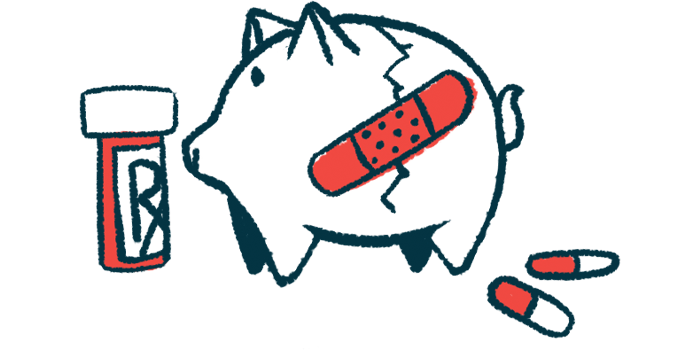Cost of ALS care in US in first year tops $47K for Medicare users
Amount is over 3 times what's spent by average program user, per study

People with amyotrophic lateral sclerosis (ALS) spend upward of $47,000 on medical care during the first year after their diagnosis, more than three times the amount spent by the average Medicare user, according to a new study by the ALS Association.
The study results further showed that so-called patient liability — the portion of costs not covered by Medicare — was also more than three times greater for ALS patients. Those costs were more than $6,500 for people with ALS versus slightly more than $2,000 for those without the neurodegenerative disease, according to an ALS Association press release detailing the study findings.
“Understanding the magnitude of the financial burden faced by people living with ALS and the health care system is essential if we are going to reduce the harms of ALS and make it a livable disease,” said Sarah Parvanta, PhD, the ALS Association’s senior director of mission informatics and a coauthor of the study.
Although there are approved disease-modifying therapies, “only about one-third of Medicare beneficiaries with ALS take [such] medication,” per the association. This was unexpected based on current guidelines, the release noted. Still, the high cost of these medications contributes to making the disease so expensive to treat, according to the nonprofit.
The study, “Medicare Expenditures in the First Year of Amyotrophic Lateral Sclerosis Diagnosis,” was published in the American Journal of Managed Care. It was funded by the ALS Association.
People with ALS experience symptoms such as muscle weakness, twitching, and difficulty speaking, swallowing, and breathing, all of which worsen over time. The medical costs for ALS are high, exceeding $1 billion each year in the U.S. alone, and continue to increase as the diseases progresses, for both patients and the healthcare system.
“ALS is a devastating disease — physically, emotionally, and financially,” Parvanta said. “Our goal was to quantify the medical costs accumulated throughout the first year following an ALS diagnosis and get a better understanding of the types of care that drive up these costs.”
About two-thirds of ALS patients in US covered by Medicare
Approximately two-thirds of people in the U.S. who are living with ALS are covered by Medicare, an insurance program for people 65 and older and younger people with disabilities. To better understand the burden of this disease, the research team — from the association and Avalere Health, a healthcare business consulting firm — compared Medicare claims from people with and without ALS.
The team specifically looked at Medicare fee-for-service claims from 2017 to 2021. That comprised medical claims and claims related to prescription drugs. During that period, 11,260 people had claims consistent with an ALS diagnosis and available follow-up data spanning at least six months before diagnosis to six months after it.
The data showed that ALS patients had a mean Medicare spending of $47,450 in the year after diagnosis — more than 3.5 times the $13,890 spent by people without ALS. Short-term hospital care was the largest expense ($11,237 vs. $3,249).
Durable medical equipment, such as wheelchairs, added $5,583, while prescribed medications accounted for $6,309 compared with $2,966 for those without ALS. On average, people with ALS also paid $6,802 out of their own pockets each year, more than three times the $2,050 paid by those without the disease.
Still, this study did not account for all the extra costs incurred by ALS patients, the researchers noted.
“We know the financial burden of ALS is underestimated by this study because the Medicare dataset did not include any non-medical costs, like a wheelchair-accessible vehicle, home modifications, or lost income,” Parvanta said. “These expenses can be overwhelming and cause stress, added work burden, and debt for people living with ALS and their families.”
Study finds one-third of patients using available disease-modifying drugs
“Surprisingly,” according to the ALS Association, a claim for Radicava (edaravone) — an ALS infusion therapy approved in 2017, and now available in an oral formulation as Radicava ORS — was filed by fewer than 600 study participants, specifically 580 or 5.2%, in the first year after diagnosis. In that same one-year period, slightly more than 30% of ALS patients, 3,574 in total, filed a claim for riluzole. That medication is approved as an oral suspension called Tiglutik, and as tablets under generic versions.
The researchers noted that the study findings “indicate that approximately one-third of [Medicare] beneficiaries with ALS are using either of the available disease-modifying drugs.” The team said that was “unexpected, given clinical practice guidelines.”
However, the team noted that these medications nonetheless accounted for a large portion of costs, either covered by supplemental insurance or paid out of pocket.
This study shows that current ALS treatment and care already [present] affordability challenges, so policymakers must consider how Medicare will address this significant cost burden. … People living with ALS should not have to forfeit their financial health to improve their physical well-being.
Kuldip Dave, PhD, who led the study and is senior vice president of research at the ALS Association, said that “making ALS livable will require new, innovative, and most-likely costly treatments that can slow down or stop further progression of the disease as well as restore lost function.”
For Dave, these findings illustrate the hurdles ahead.
“This study shows that current ALS treatment and care already [present] affordability challenges, so policymakers must consider how Medicare will address this significant cost burden,” Dave said. “People living with ALS should not have to forfeit their financial health to improve their physical well-being.”








